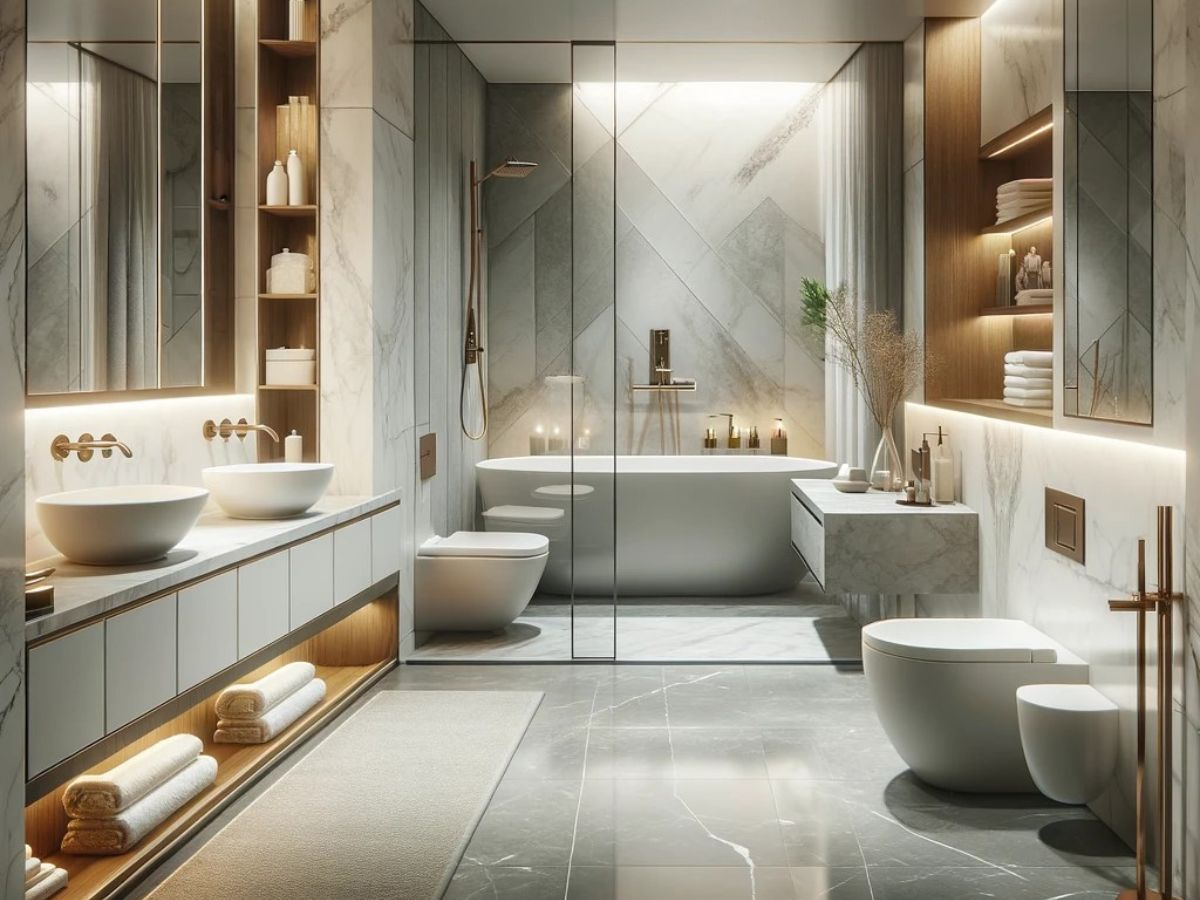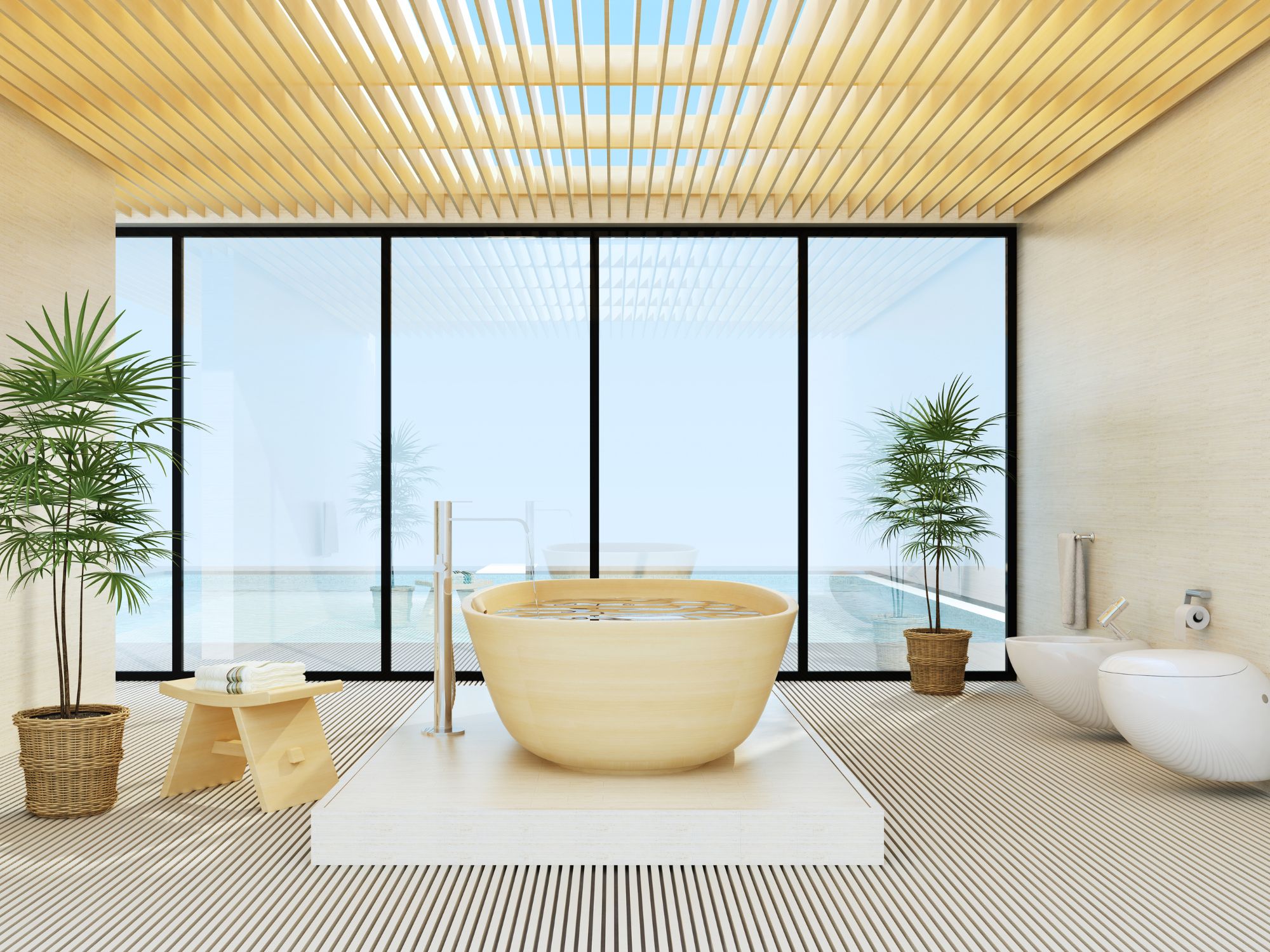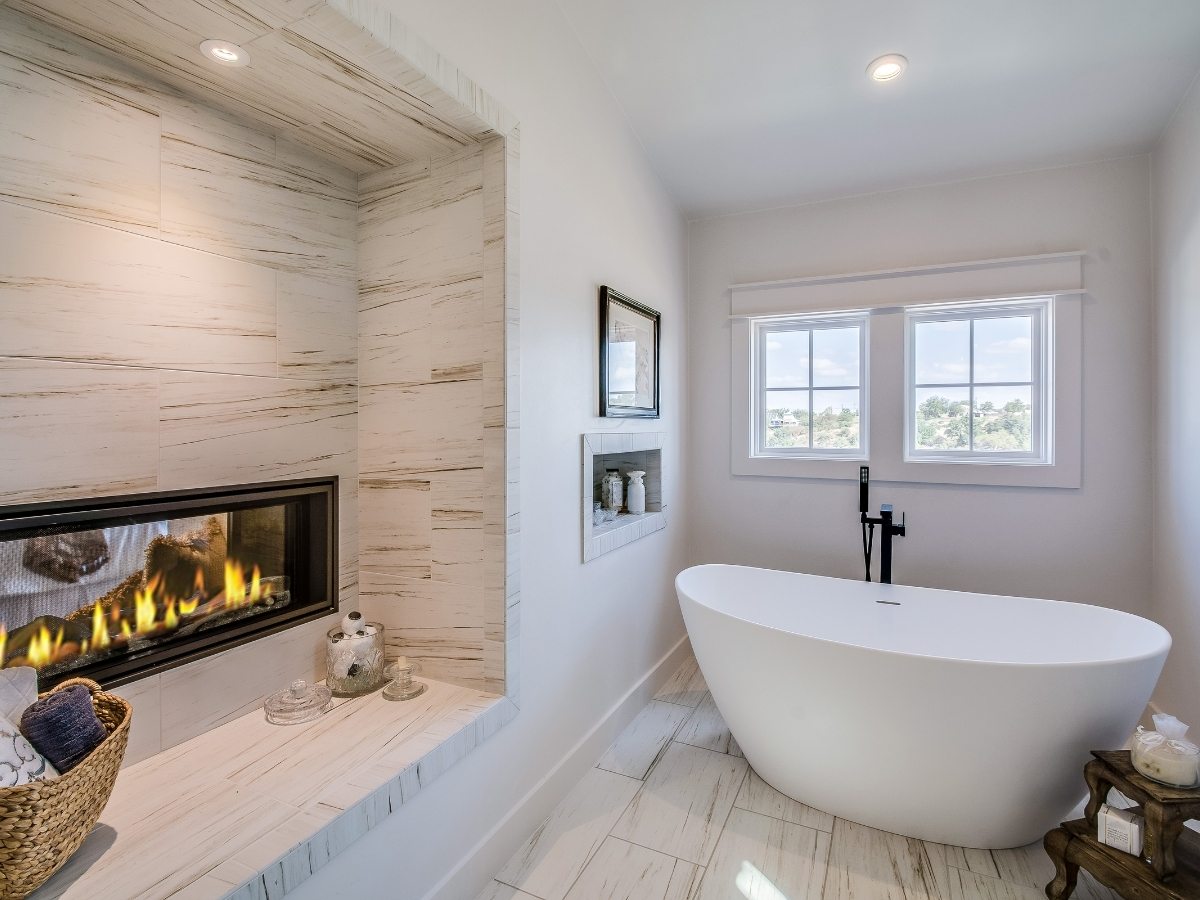1. Bathroom Remodeling – Investment Property
An investment property refers to a real estate asset purchased with the intention of earning a return on the initial outlay of money used to acquire the asset. This return can come through rental income, the future resale of the property, or both.
Investment can be for a long or short term endeavor. Short term such as in “flipping” where a property is purchased, renovated, and then sold at a higher price. Long term as in owning to rent.
Investment properties are distinct from personal residences. Homeowners actively welcome value appreciation over time, while investors specifically acquire investment properties to generate income or profit within the shorter timeframe. The success of an investment property depends on several factors. The location, market conditions, property condition and potential for appreciation.
The value added by a remodeled bathroom to an investment property can vary depending on several factors. These include the scope, scale, and complexity of the remodel. The value can also depend on the quality of materials and fixtures used and the local real estate market dynamics.
The Allure of Bathroom Remodels
Bathroom Remodeling transcends mere cosmetic upgrades. It embodies a calculated endeavor aimed at augmenting the intrinsic value of a dwelling. Remodeled bathrooms harbor a transformative potential and can be the jewel of all home remodeling endeavors. Industry experts recognize bathroom renovations as one of the most lucrative home improvement initiatives.
It’s important to note that the exact value added by a bathroom remodel can vary based on individual circumstances. However, investing in upgrades that enhance both functionality and aesthetics yield significant returns on investment i.e. increased property value.
In the foregoing when we refer to “Investor” we use this term very loosely. It can be an individual attempting to acquire a “fixer upper” to flip quickly or a larger more specialize entity. The basis of engagement is the same or similar for both cases. However, not many do take the sophisticated walk!
Purpose of Article
This article, the third of a five part series arms homeowners and small investors with decision rules. The goal is to provide insights into the factors that influence bathroom remodel on property values by reviewing some typical cases and scenarios.
The first article focused on compiling a Bathroom Remodel Cost Budget for your remodel project. In the second article we explored How Much Should You Spend on a Bathroom Remodel. The forth article provided insights and guidance in making remodel decisions relative to selecting Bathroom Remodel features that favors Enjoyment Value verses those that favor Return on Investment so as to foster decisions that promote financial recoverability.
In the fifth and final article we will review frequently asked questions and other issues.
In this article we revisit similar issues from the perspective of investment properties. We will review various unique cases and provide guidance on how best to to enhance ROI by maximizing Surplus. This article contains some mathematical expressions, economics and financial concepts which are necessary to help situate ideas related to real estate investment decisions. We request your patience.
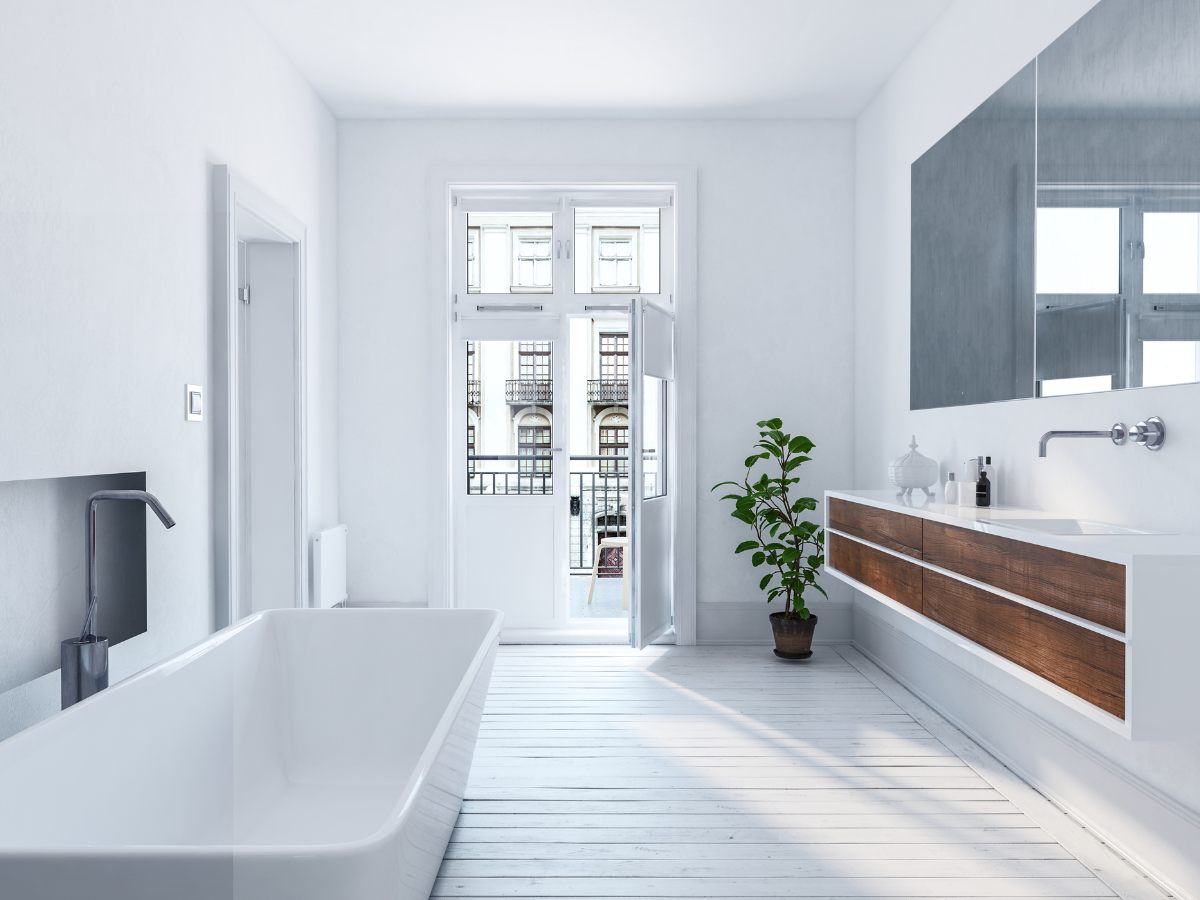
2. Some basic Terminology – Investing in Real Estate
In theory a remodel adds an amount proportional to the Return on Investment (ROI) to the Property Market Value. An ROI of 20% adds an equivalent value to the property assuming the recoverability of the investment is 100%. In general, the magnitude of the ROI may reflect the scale or market alignment of the remodel.
A larger ROI may reflect the potential of a more extensive or high-end remodel. However a higher ROI may or may not significantly enhance the property’s appeal when contrasted with a lower ROI which may focus more on cosmetics.
On average a well-executed bathroom remodel can increase the value of a property anywhere from 10% to 20%. Whereas a bathroom remodel may recoup around 60% to 70% of the expended cost of the remodel.
We will rely on these observations to build a working model. We will use the model to share light and demonstrate how decisions should be made relative to bathroom remodeling. The model does not need the data perse but the data is useful to illustrate the foregoing.
Financial Gap/Loss and Enjoyment Value
The difference between the “Bathroom Remodel Cost” and “Property Increment Value” represents the “Surplus Value” which can be a financial loss or gain. The amount spent on the remodel which exceeds the asset’s value appreciation represents this Surplus.
As we will demonstrate below shortly, scenarios with higher recoup rates show a smaller gap.
We can also consider the financial gap as an “Enjoyment Value,” especially when the Surplus is negative representing the remodel’s intangible benefits for property enjoyment. We discussed this in a previous article as noted above, so please refer to it.
From the definition of Recoup Rates, the Bathroom Remodel Cost is always greater than the Property Increment Value. This is because the Recoup Rate is usually less than 100%. Therefore, the difference between the Property Increment Value (PIV) and the Bathroom Remodel Cost (BRC) is a net negative value.
Therefore, when accounting for recoup rates the Surplus can be a Financial Gain, Loss, or zero.
Remodel Cost and Recoup Rates (RR)
Recoup Rates (RR) implies the percentage of the Bathroom Remodel Cost (BRC) that is recovered. The gap between the Bathroom Remodel Cost and the Increment Value represents a net Surplus.
Higher recoup rates might be achievable with strategic remodeling choices that align closely with market demands or through cost-effective remodeling practices. The percentage loss is deemed the result or the net effect of remodel decisions, or economic, and financial factors.
Please refer to our article for a more detailed analysis of recoup rates – How Much Should You Spend on a Bathroom Remodel? A Home Owner’s Dilemma. A brief recap is provided below.
3. factors influencing Recoup Rates
Property improvements, such as bathroom remodels, face immediate depreciation once completed. The wear over time and shifts in style trends decrease the value that these upgrades add to a property. This devaluation, coupled with the subjective nature of the worth of remodel improvements, means that what one person prizes may not hold value to another. This is the premise which challenges the assumption that improvements will equate to a direct increase in property value.
Real estate market trends further complicate decisions, as what is trendy during the remodel may not remain so by the time the property is sold. This has the effect of potentially diminishing the added value.
The financial outlay for remodels encompasses materials and labor. Labor may not necessarily contribute to a resale value perse potentially leading to losses when the property is valued.
Over-customization can also deter buyers, limiting the buyer pool and impacting the overall property value. Additionally, money spent on remodeling bears an opportunity cost, where alternative investments might have yielded greater returns.
If financed, the remodeling incurs interest payments that increase the total expenditure, making recouping the investment even harder. Consequently, most improvements do not fully return their cost at sale.
Due to a combination of the above noted factors recoup rates are typically less than 100%, highlighting the importance for investors to be strategic.
4. Investing in Real Estate Working Model
To set the stage for our analysis we will need to set up a working model. This model will allow us to see the behavior of the value added less the cost of the remodel. The resulting quantity is equal to the net Surplus “economic benefit/gain/loss”.
The equation is noted below as:
Left side of Equation is the Property Increment Value (PIV): [Property Increment Rate (ROI) x Property Value (PV)]
Right side of Equation is the Recoup Value (RV): [Bathroom Remodel Cost (BRC) x Recoup Rate (RR)]
Left Side Minus the Right Side Equals: Surplus (Financial Gap/Loss/Gain).
With a bit of manipulation we can express the above as follows:
1. ROI = [RR + %Net Surplus] x %BRC] The ROI is gross before all categories of deductions and expenses.
2. % Net Surplus = Surplus / BRC
3. %BRC = Bathroom Remodel Cost / Property Value
4. RR(e) = [RR + %Net Surplus]
5. ROI = RR(e) x % BRC
6. %Surplus Value Return = Surplus / Property Increment Value
Understanding The Model
The final expression (Equation No. 5) indicates that the ROI is the result of an equivalent Recoup Rate (RR(e), and the %BRC. The RR(e) is composed of RR and the “%Net Surplus”. The latter refers to any gain/loss acquired over and above the constraint imposed by the Recoup Rate. It is the net change in property value or reduction in cost the investor is able to achieve or influence through cost reductions, and cost control mechanisms, risk mitigations, economies of scale, and other market events.
The investor is concerned with maximizing net positive “Surplus Value” not necessarily “Enjoyment Value”
Note that the Bathroom Remodel Cost (BRC) is the only factor that the property owner can directly influence; the wider market fixes everything else once remodeling decisions are made. The investor indirectly influences the remaining factors such as RR and ROI.
Also the ROI is an interplay between the %BRC and the %NetSurplus. As %BRC decreases the %NetSurplus potentially increases in such a way that given the right market conditions and investor’s actions or decisions causes the ROI to be maximized.
The Bathroom Remodel Cost (BRC) remains key to the profitability of the investment, i.e. %BRC. Because every investor targets a ROI, an investor may preset a target ROI(t) at which an investment, %BRC is made in a remodel activity. This is a key difference in making remodel investments as a homeowner verses as an investor.
Investor Target ROI(t)
Investment properties undergoing a remodel would require a target ROI(t), a high RR, and a value of %BRC that maximizes %net Surplus.
Note that there are rare occasions when RR is greater than 1, for example during a heated real estate market, when multiple offers are being considered. In this case the bathroom may be the focal point which may cause escalating offers on a property.
However, from an economic efficiency perspective the maximum value of RR is 100% or 1. This indicates that if the RR is 60% the net positive Surplus can potentially be influenced positively upwards to the theoretical or practical hard limit of 40% or more depending on the market circumstance as noted above!.

5. Recoup rates, ROI and Investment Efficiency
For a given remodel investment compared under two ROI scenarios, say10% and 20%, the scenario with a 20% ROI will generally show a closer alignment between the remodel costs (red or green lines) curve and the Property Increment Value curve (blue line), refer to Graphic No. 1.
This is because the cost of the remodel would be the same under both scenarios. A higher ROI will cause the curve with the higher effective recoup rate RR to increase significantly. As a result the corresponding remodel cost curve would move downwards closer to the Property Increment Value Curve (blue line).
In summary, as the effective Recoup Rate approaches “100%” the Remodel Cost Curve and the Property Increment Value Curve move closer together. This suggests that more ambitious remodeling projects that significantly boost property values might also come closer to breaking even or yielding a net positive financial return when executed efficiently.
Graphic No. 1

Observation 1 - Decreasing Recoup Rates have an adverse escalating impact on Bathroom Remodel Cost, while upward movements in the ROI will potentially lead to a net positive financial gain and vice verse for the same Remodel Cost depending on the relative interplay between ROI rates and RR.
6. Model Scenario Analysis For Strategic Investment Decisions
Having framed the model, the remainder of this article will review 6 cases as noted below to provide some insight as to the strategic remodeling decisions under each case.
Bathroom Remodel Model Scenario Analysis: Case 1. - Remodel Project is completed but changes in ROI Occurs Case 2. - Remodel Project is being planned at a target ROI(t) and market expects a different ROI Case 3. - Remodel Project is completed but changes in the RR Occurs Case 4. - Remodel Project is being planned at a RR and market returns a different RR Case 5. - Comparing two remodel projects at different market conditions with different RR and ROI(t) Case 6. - Comparing two remodel projects within same market with same RR but different ROI(t)
7. Case 1: Remodel Project Completed amidst recent changes in ROI
Upon completing a bathroom remodel in an investment property, if the investor observes an unforeseen shift in the Return in Investment return (ROI), several strategic decisions could come into play. This shift could be the result of various factors, including changes in market demand, economic downturns, or emerging trends that affect property values differently than anticipated.
Improving Market – Investing in Real Estate
From the Graphic below if the project was built based on market conditions of ROI 13%, %BRC of 22% and RR of 60% (yellow dot) an increase in ROI beyond the initial target (to red dot) presents a lucrative opportunity to sell the property at a premium near a ROI of 14% without having to invest at a %BRC of 25.
But this is only possible if the remodeled features, upgrades and luxury additions are able to attract potential buyers willing to pay a higher price for perceived value and quality of the already built remodel.
Graphic No. 2
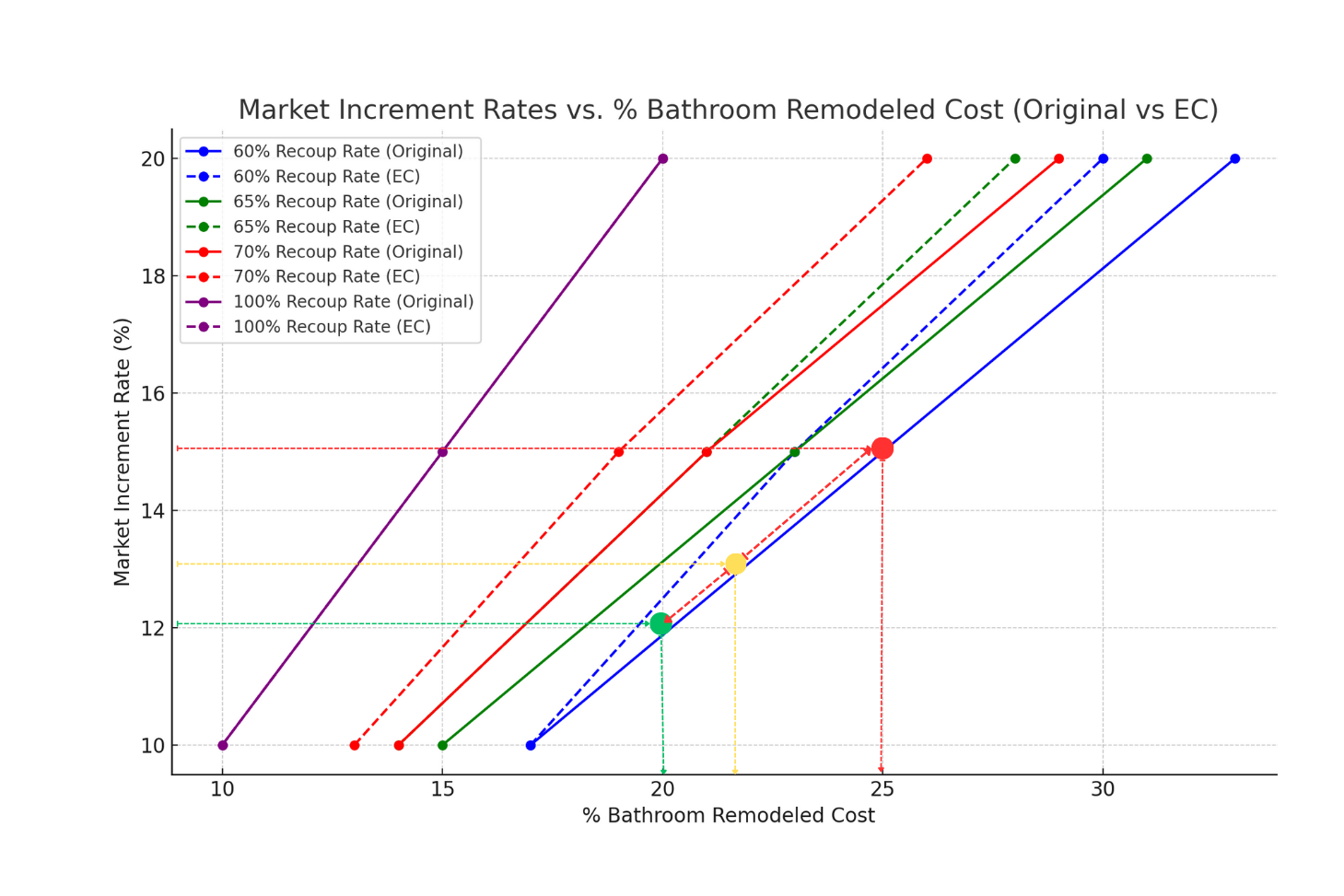
Deteriorating Market – Investing in Real Estate
Conversely, a decrease in ROI from the target ROI (yellow dot) with an ROI of 13% and %BRC of 22, to ROI of 12%, and %BRC of 20 (to green dot) has an adverse effect. This would necessitate a re-evaluation of the investment strategy. For starters the current market conditions requires an investment of %BRC of 20 but an investment equivalent to a %BRC of 22 was built.
The investor’s options are either to hold off on selling the property until market conditions improve, provided the carrying costs are manageable and is less than any losses that would be realized by not selling. Alternatively, adjusting the asking price to more accurately reflect current market conditions.
Referring back to the Model Equation “ROI = [RR + %Net surplus] x %BRC” and from Graphic No. 2 above, it is evident that RR is 60% and assumed to be fixed, %BRC is also fixed since the project is completed. The decrease in ROI is a result of market factors that impact the %NetSurplus. However, if RR is not fixed as was assumed, but also decreasing, then the net effect on %NetSurplus can be significantly greater.
Observation 2 - In such market situations the property's enhanced appeal due to the remodel features is the only mechanism through which to recover the investment. Therefore, the desired economic outcome is really premised on the remodel decision-making process prior to completion. The quality and extent of the bathroom remodel are key.
High-quality finishes, efficient layouts, and features that appeal to a broad buyer base e.g. modern fixtures, energy-efficient lighting, and neutral yet stylish materials can help mitigate the impact of a lower-than-expected ROI by attracting more interest and potentially higher offers from buyers.

8. Case 2: investment property Remodel Planned Then Market ROI Changes
When planning a bathroom remodel in an investment property with a specific ROI in mind, investors must remain vigilant to changing market conditions as these can impact the expected return. Market shifts can occur due to various reasons, including economic changes, shifts in buyer preferences, or new decor or real estate trends.
Improving ROI Market
If market conditions improve during the planning phase, indicating a potential for higher ROI than initially projected, investors might consider expanding the scope of the bathroom remodel to include more luxurious features or higher-end finishes. This could involve installing premium fixtures, designer tiles, or advanced technology like smart showers or heated floors.
The intention would be to further increase the property’s market value and attractiveness to potential buyers, leveraging the positive shift in market dynamics to maximize profitability upon sale.
Referencing the previous diagram Graphic No. 2 above, an increase in ROI to 15% is an opportunity that needs to be explored. As the diagram shows at an ROI of 15% in a market with a RR of 60% this would require an investment with BRC of 22%.
However, it may be possible to stay at the current investment level or invest a little more and still reap an ROI near 14%.
This is possible if cost reduction or economies of scale measures are applied or strategic features are added based on market research. These measures would move the project from an RR of 60% (solid blue line) to RR(EC) of 60% (dash blue line).
Observation 3 - In an increasing ROI market the investor's decision is really twofold. Whether to stay at the current level of investment and reap benefits greater than planned or increase the level of investment to take full advantage of the market upswing.
The decision to invest more will depend on market research and understanding future potential.
Deteriorating Market
However, if market conditions deteriorate, signaling a decrease in the anticipated ROI, investors face a critical decision. It may become necessary to scale back the remodel plans say (from yellow dot to green dot) to focus on essential updates that still improve the property’s appeal without incurring excessive costs.
This could mean prioritizing cost-effective improvements that offer the most significant impact on the bathroom’s appearance and functionality, such as updating fixtures, repainting, or replacing outdated tiles with more affordable yet modern options.
Furthermore, within a sustained market decline in ROI an investor must carefully manage their budgets to maintain a balance between the cost of the remodel and the expected sale price of the property. This involves meticulous planning and potentially negotiating with contractors and suppliers to secure the best prices for materials and labor without compromising on quality.
It is not a good idea to use poor quality finishes, materials and fixtures and expect to reap higher than the corresponding ROI for the given market RR. That will surely lead to poor returns and bad reputation.
Observation 4 - The key to navigating and adjusting remodel plans to market changes lies in the strategic approach and alignment of the investment in terms of being flexible and adjustable to market nuances, trends (not fads), buyer preferences and expectations, studying comparable sales in the area, monitoring economic indicators that influence real estate markets, and gathering feedback from real estate agents. Declining ROI does not necessarily imply a corresponding decrease in investment. The decision to invest more or not will depend on market research and understanding future potential.

9. Case 3: investment property Remodel Completed then Changes in RR occurs
After the completion of a bathroom remodel in an investment property, changes in the Recoup Rate RR can significantly impact an investor’s profitability. As noted above the recoup rate reflects the net change in home value relative to the remodel cost, factoring in market dynamics and property appeal enhancements.
Improving RR Market – Investing in Real Estate
An increase in RR suggests that the market values the renovations higher than anticipated. Potentially due to rising demand for updated properties or shifts in buyer preferences that favor the specific features or aesthetics introduced in the remodel.
From the Graphic below, this would involve a shift from the yellow dot at RR of 60% to the green dot at RR of 65%. Given that the remodel is complete the change in RR(e) must involve a change in ROI as noted in the Graphic. Therefore, there would also be a positive increase in the %net Surplus.
Observation 5 - In this scenario, the investor should reassess the property's market position, consider listing the property at a higher price point to capitalize on the increased RR. This might involve marketing the property more aggressively, highlighting the unique selling points of the remodeled bathroom, such as energy efficiency, modern design, or luxury finishes that now have greater appeal in the current market.
Graphic No. 3
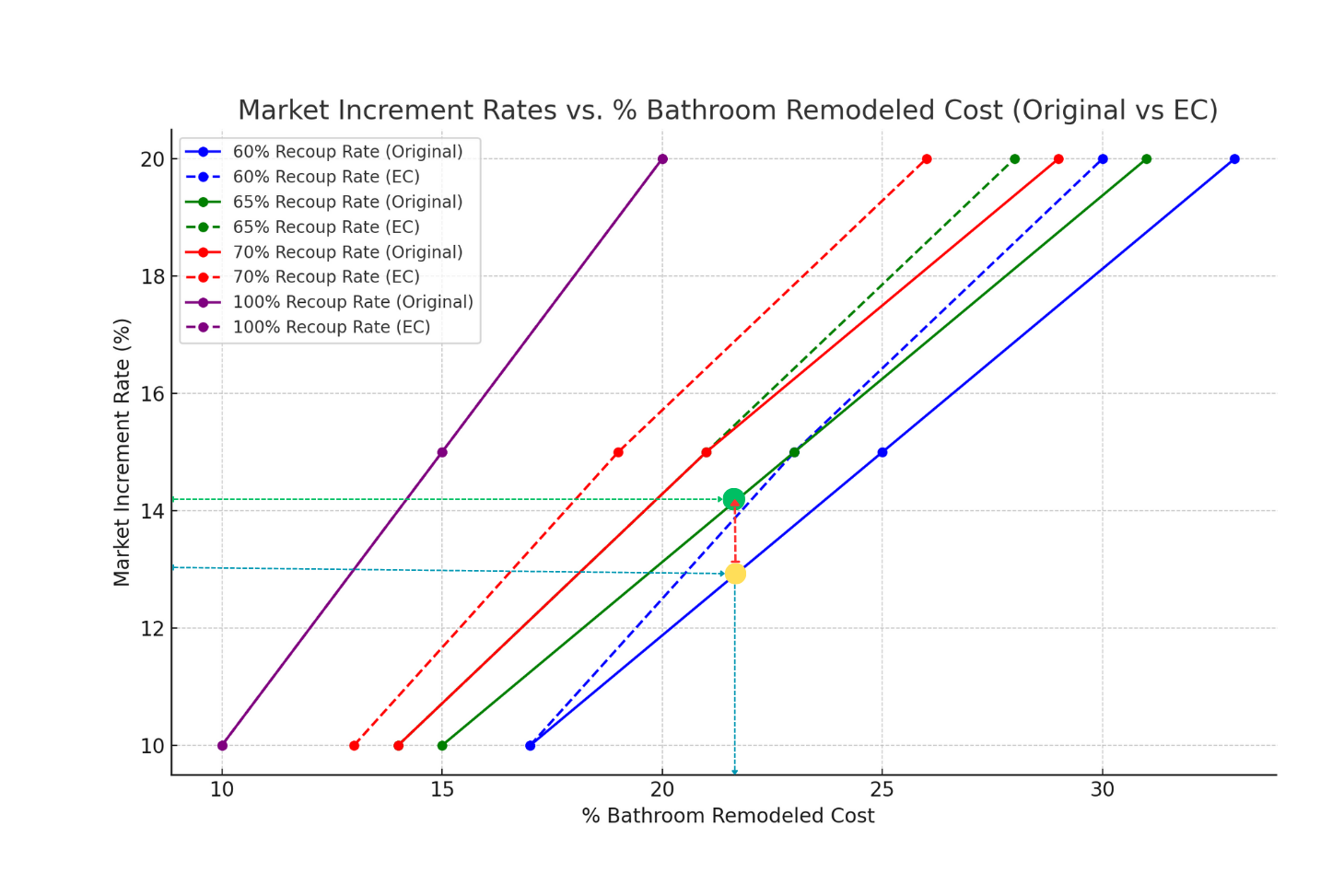
Deteriorating RR Markets – Investing in Real Estate
Conversely, a decrease in RR post-remodel requires a strategic pivot. It may indicate that the market does not value the renovations as highly as expected or that broader economic conditions are affecting buyer willingness to pay a premium for remodeled properties.
In this case, the investor might need to adjust their selling strategy, potentially lowering the asking price to align with market expectations or emphasizing other desirable features of the property beyond the bathroom remodel to attract buyers.
This is why the remodel features and plans should not be based on what the investor personally desires as this will most likely lead to high opportunity cost of investment and lost capital.
Observation 6 - Understanding market dynamics can inform adjustments to the selling strategy, whether that means repositioning the property in the market, altering the marketing approach, or revising pricing expectations. Effective communication of the value added through the bathroom remodel features becomes crucial, especially in a market where RR has decreased or is decreasing.
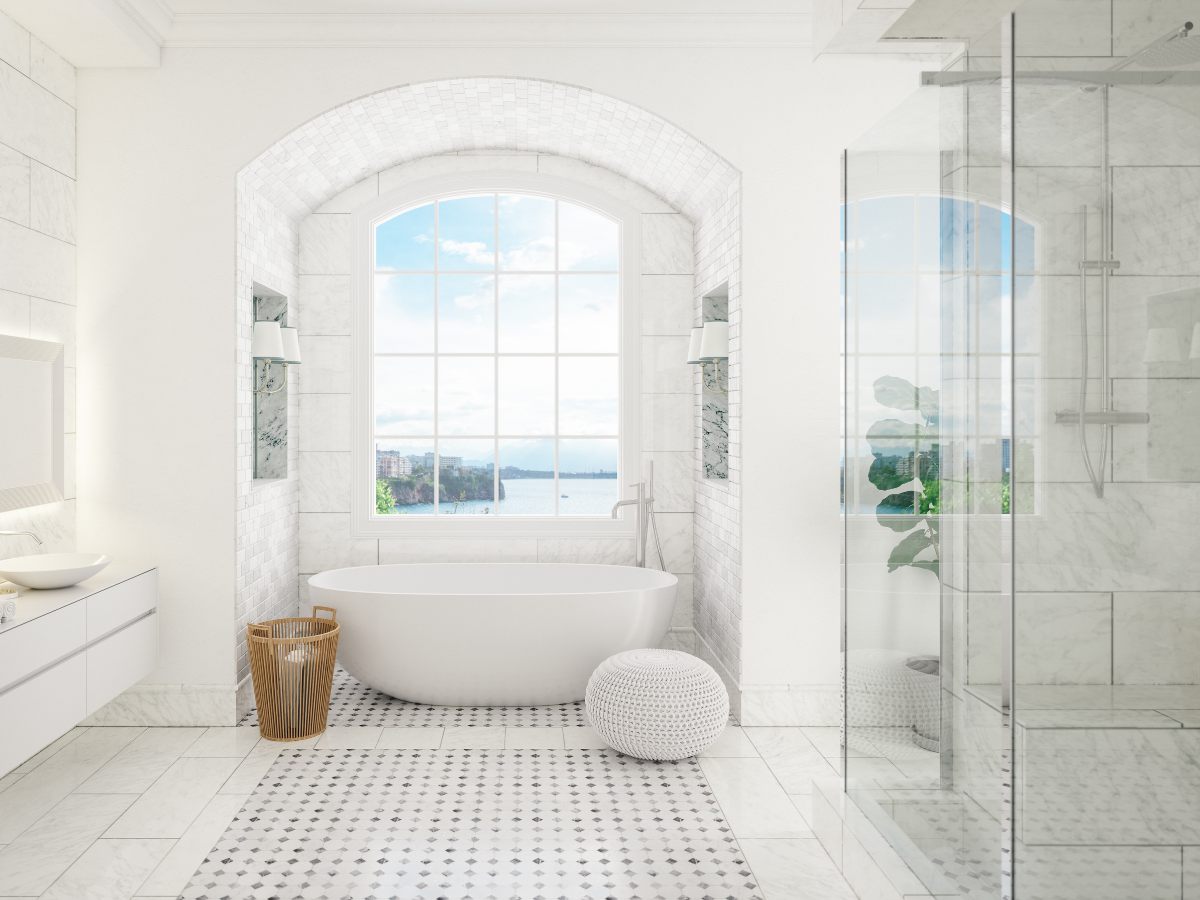
10. Case 4: Planning an investment property Remodel with Changes in RR
When planning a bathroom remodel in an investment property with a specific equivalent Recoup Rate RR in mind probably based on historical data, market changes can alter the anticipated RR and significantly impact the investment strategy.
The RR is a critical measure, reflecting the net change in home value relative to the investment made in the remodel. An investor’s initial calculations might be based on current market conditions, expected trends, and the perceived value of proposed renovations. However, market dynamics are fluid, and shifts can either enhance or diminish the projected value of these renovations.
Improved RR Due to Market Uplift
If the market conditions shift favorably, increasing RR, investors might find an opportunity to amplify the scope of their bathroom remodel. This could involve incorporating higher-end finishes, more extensive layout changes, or advanced features like smart home technology. These features are now more likely to be valued by potential buyers.
However, the “time to market” of these features need to be relatively quick so as not to miss the opportunity.
The positive shift in RR suggests that the market is willing to pay a premium for properties that offer these upgraded features, providing a stronger incentive to enhance the remodel plan to capitalize on this trend.
There are two ways the investor can approach this scenario given that the remodel is not yet implemented. From the Graphic below it is evident that moving from a RR of 60% to an RR of 65% can be achieved in two ways.
First by keeping the current investment level at a %BRC of 22% would result in a shift of ROI from 13% to a ROI just above 14% as RR rates increase. Secondly, by reducing the investment down to a %BRC of 19.5%, staying at the current target ROI(t) of 13%.
Observation 7 -Increasing RR, favors incorporating higher-end finishes, more extensive layout changes, or advanced features like smart home technologies. These features are now more likely to be valued by potential buyers. These must conform to the local market.
Scenario Analysis – Increasing RR
The foregoing is based on our model equation, ROI(t) = [RR + %Net Surplus] x %BRC(t) and using data from the Graphic above. Based on the particulars of Scenario A – moving from the Yellow Dot to the Green Dot, and for Scenario B – moving from the Yellow Dot to the Red Dot. We assume the planned investment is $0.4M.
| Scenario A | Scenario B | |||||
|---|---|---|---|---|---|---|
| Metrics | Green Dot | Yellow Dot | Difference | Red Dot | Yellow Dot | Difference |
| Return on Investment | 14.2% | 13% | 1.2% | 13% | 13% | 0% |
| %NetSurplus | 4.5% | 1% | 3.5% | 1.7% | 1% | 0.7% |
| Recoup Rate | 65% | 60% | 5% | 65% | 60% | 5% |
| Equivalent Recoup Rates | 69.5% | 61% | 8.5% | 66.7% | 61% | 5.7% |
| Surplus Value Return | 7% | 2% | 64% | 3% | 2% | 1% |
| Surplus Value | $3,960 | $880 | $3,080 | $1,326 | $880 | $446 |
| Recouped Value | $57,200 | $52,000 | $4,400 | $50,700 | $52,800 | -2,100 |
| Property Increment Value | $56,800 | $52,000 | $4,800 | $52,000 | $52,000 | |
| Bathroom Remodel Cost | $88,000 | $88,000 | – | $78,000 | $88,000 | -$10,000 |
Data Analysis
From the data in the above table it is evident that moving from the “Yellow Dot” to the “Green Dot” is more economically rewarding than moving to the Red Dot. In other words, staying at the same investment level is preferable to reducing the planned investment. Every metric supports this course of action, see table above.
Given that the Recoup Rate is increasing, the investor may be tempted to reduce the investment such that it aligns with the new RR at (Red Dot) – but this would lead to a significant net reduction in Surplus Value, and Property Increment Value when compared to staying at the initial planned investment level at Yellow Dot.
The key observation from the data is that it is better to maintain the same level (Scenario A) of investment at $88,000 and take advantage of any increase in RR and reaping a corresponding increase in ROI as RR increases.
Given that this project is still in the planning stage it is advisable to maintain the path that maximizes the %Surplus Value Return. In this case this requires that the same investment level as previously set be maintained.
Observation 8 - Responding to market movements is not always a simple adjustment of investment levels in the same direction as key market parameter changes but may involve choosing the right pathway through which to maximize the % Surplus Value Return when market conditions becomes favorable in the future. This is critical and should be premised on market behavioral trends both past and future.
Graphic No. 4

Decreased RR Due to Market Downturn
Conversely, if market conditions deteriorate, reducing the expected RR, the investor posses a more challenging situation. The anticipated value of the bathroom remodel may no longer justify the initial investment returns, which may necessitate a re-evaluation of the remodel’s scope.
The investor may choose to prioritize updates that are most impactful to buyers, such as modernizing fixtures and finishes, while deferring more ambitious projects that would have been viable under a higher RR. However, perspective is key.
Cost-effective updates that maintain or slightly improve the property’s appeal without overextending the budget may help.
Perspective is Everything
To see how critical this decision is let’s again refer to the Graphic above. If we assume we are planning our remodel project starting at the conditions identified at the red dot (ROI of13%, %BRC 19.5%) then the investor has two ways of dealing with a decrease in RR.
First, an increase in the investment amount is possible and represented by a horizontal move from the Red Dot (at green line) RR(65%) to the Yellow Dot (at blue line) RR(60%), assuming the investor wants to maintain the target ROI(t) of 13%. This may not seem to be an economically rational behavior given the falling RR.
However, if the investor has performed market research indicating perhaps that the downturn is to be short lived, then investing to the Yellow Dot is an optimal decision which can be capitalized readily when market is experiencing an upswing in RR, (refer to Graphic 4) to green Dot. This move also provides opportunity to take advantage of economies of scale reaching an ROI of 14% even before the RR increases back to 65% again.
Secondly, the investor may take the conservative approach to maintain the same level of investment at %BRC of 19.5 with the expectation of receiving a reduced ROI of 11.8% when the RR falls to 60%, compared to the initial ROI of 13%, (blue dot). This reduced ROI may be considered acceptable and may present some opportunity for cost reductions from the solid blue line to the dash blue line at a ROI of about 12%.
Scenario Analysis – Decreasing RR
The foregoing is based on our model equation, ROI(t) = [RR + %Net Surplus] x %BRC(t) and using data from the Graphic above. Based on the particulars of Scenario A – moving from the Red Dot to Yellow Dot (representing a decrease in RR), and for Scenario B – moving from Red Dot to Blue Dot (also representing a decrease in RR). We assume the planned investment is $0.4M.
The question now becomes which investment decision response is preferable for a case when RR is declining? We shall now explore this further in order to provide a way forward.
| Scenario A | Scenario B | |||||
|---|---|---|---|---|---|---|
| Metrics | Blue Dot | Red Dot | Difference | Yellow Dot | Red Dot | Difference |
| Return on Investment | 11.8% | 13% | -1.2% | 13% | 13% | 0% |
| %NetSurplus | 0.51% | 1.67% | -1.16% | -0.91% | 1.67% | -3% |
| Recoup Rate | 60% | 65% | -5% | 60% | 65% | -5% |
| Equivalent Recoup Rates | 60.51 | 66.67% | -6.16% | 59.1% | 66.67% | -8% |
| Surplus Value Return | 0.8% | 2.5% | -18.85% | -1.5% | 2.5% | – |
| Surplus Value | $398 | $1,303 | -$905 | -$801 | $1,303 | -$2,103 |
| Recouped Value | $46,800 | $50,700 | -$3,900 | $52,000 | $50,700 | $2,100 |
| Property Increment Value | $47,200 | $52,000 | -$4,800 | $52,000 | $52,000 | – |
| Bathroom Remodel Cost | $78,000 | $78,000 | 0 | $88,000 | $78,000 | $10,000 |
Data Analysis
The data indicates that investing an additional $10, 000 is essential to offset property increment value reductions of $4,800 if the Red Dot to Blue Dot pathway is selected. The key parameters that indicate that moving to the Yellow Dot from the Red Dot is the best strategy are – the ROI is maintained at the desired target level of 13%, the Surplus Value Return decreases slightly but not as significantly as when moving from Red Dot to Blue Dot. Also the Surplus Value decreases by -$2,103 when moving from Red Dot to Yellow Dot but is offset by an increase in Recouped Value, $2,100.
Therefore, increasing investment in a declining RR market can be justified if the right metrics are explored. It is essential that the investor understands the local market and the wider market effects. The increase investment positions the remodel to take advantage of economies of scale and other market scale and dynamic opportunities.
Observation 9 - In this case, the focus shifts from maximizing the efficiency of each invested dollar (when RR is increasing) on the remodel to maintaining or right sizing the level of investment (when RR is decreasing) given the new market constraints - so as to take full advantage of future market opportunities. The key is to know your local market.
Importance of Research and Planning
Regardless of the direction of the shift in RR, the key for investors is agility i.e. being prepared to adapt their remodel plans in response to market changes to protect their investment and optimize returns by increasing the Surplus Value Return.
This requires staying informed about market trends, regularly reassessing the remodel strategy in light of new information, and being willing to make tough decisions to align/realign with current economic landscape and buyer preferences.
Maintaining a clear understanding of the target buyer demographic, current real estate market trends, and how specific renovations contribute to property appeal can guide investors in adjusting their plans effectively.
Observation 10 - The ability to pivot and realign investment strategies based on updated RR projections is critical to navigating the uncertainties of real estate remodeling investment.
11. Case 5: Comparing investment property Remodel located in Different Markets with Different RR and ROI(t)
When investors are faced with deciding between two bathroom remodel projects in distinct market situations, each with different Recoup Rates RR and target Returns on Investment (ROI(t)), it is essential to determine which project aligns better with overall investment goals.
The projects might differ in terms of the extent of the remodel activity, quality of finishes, current property values, or the market’s overall health and buyer demand but the final decision should be rooted in the data and analysis not solely on the aesthetics of the space.
Project A: High RR in a Heated Market
Consider two projects, Project A is situated in a market experiencing an upswing, characterized by strong buyer demand and increasing property values. In this scenario a high RR is potentially possible indicating that the market is likely to reward remodel investment with a significant increase in home value, surpassing the average market appreciation rate.
The target ROI(t) set by the investor for this project would be very optimistic, reflecting confidence in the market’s continued growth and the remodel’s appeal to potential buyers.
For Project A, the investor might consider a more ambitious scope, incorporating luxury finishes, advanced technology, and layout optimizations that cater to current trends and buyer preferences. The high RR justifies a larger remodel investment, anticipating that the market conditions will support a strong resale value, making this project appealing for buyers looking for a home with a featured bathroom.
From the below Graphic, Project A is noted at the red dot with target ROI(t) of 18% and an investment of %BRC of 23%. Giving the potential scale and complexity of the investment – economies of scale (EC) and cost reductions are also noted by shifting from the solid red line RR of 70% to the dash red line RR(EC) of 70% yielding a net increase in ROI of almost 2% between the two lines.
Graphic No. 5
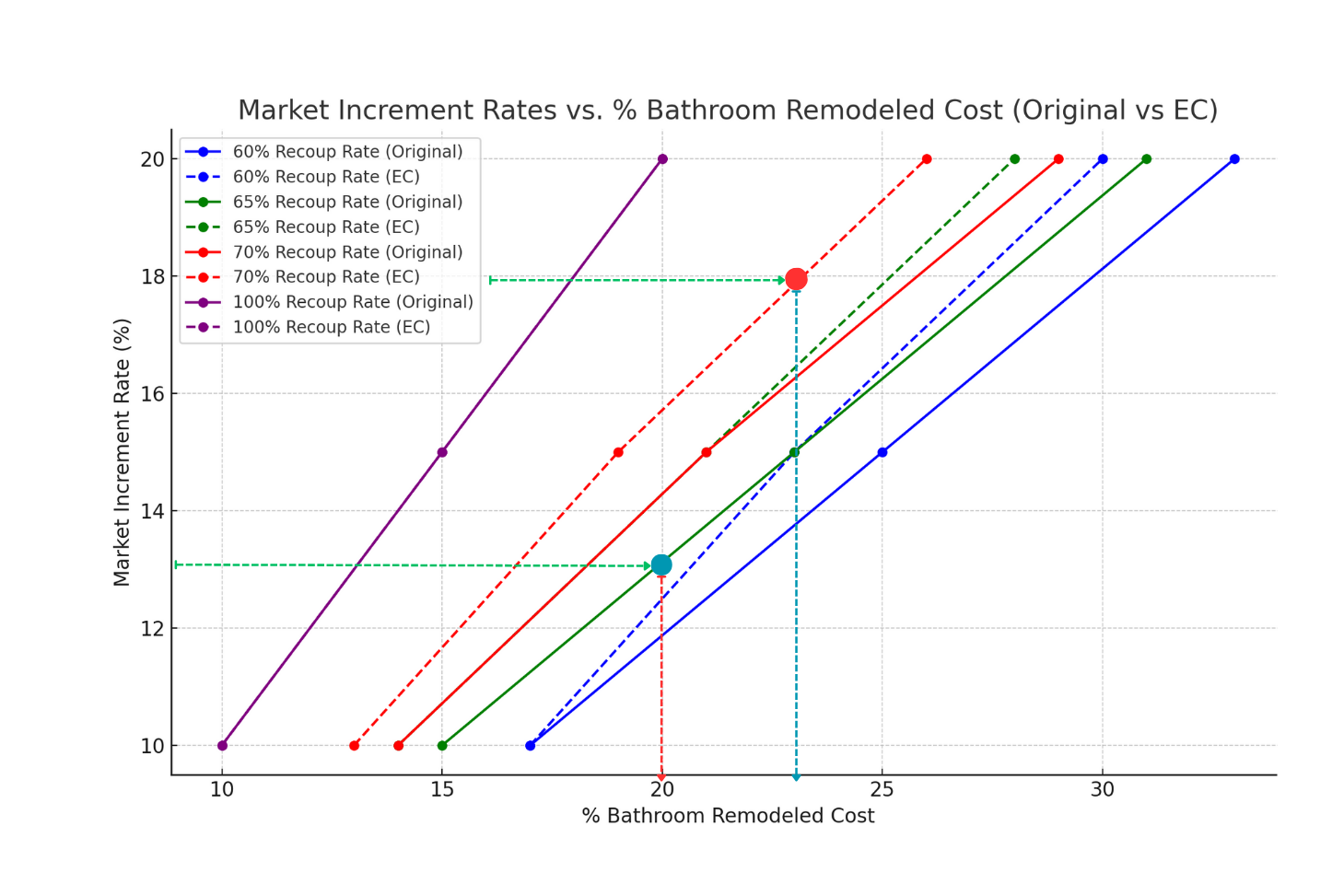
Project B: Moderate RR(e) in a Stable Market
Conversely, Project B, (blue dot) is located in a more stable market with consistent, albeit slower, growth. The moderate RR suggests that while the remodel will add value to the property, the increase is more in line with general market appreciation rates. The ROI(t) for Project B is more conservative, acknowledging the market’s limited volatility and the correspondingly lower risk and reward profile.
In this scenario, the investor might prioritize cost-effective updates that improve the property’s functionality and aesthetic appeal without overextending the budget. Focus areas could include updating fixtures, enhancing energy efficiency, and modern but not overly luxurious finishes.
Surplus Value Return and Surplus Value Considerations
Based on our model equation, ROI(t) = [RR + %Net Surplus] x %BRC(t) and using data from the Graphic above, the following table is compiled for Project A and Project B. We assume Property A have a Market Value of $0.6M and Property B, $0.4M.
| Metrics | Project A | Project B | A-B | A/B |
|---|---|---|---|---|
| Return on Investment | 18% | 13% | 5% | 1.38 |
| %NetSurplus | 2% | – | 2% | – |
| Recoup Rate | 70% | 65% | 5% | 1.08 |
| Equivalent Recoup Rate | 72% | 65% | 7% | 1.11 |
| Surplus Value Return | 3% | 0% | 4.9% | – |
| Surplus Value | $2,760 | – | $2,760 | – |
| Recouped Value | $96,600 | $52,000 | $44,600 | 1.86 |
| Property Increment Value | $108,000 | $52,000 | $56,000 | 2.08 |
| Bathroom Remodel Cost | $138,000 | $80,000 | $58,000 | 1.73 |
In Which Project Should You Invest? – Strategic Considerations
Project A seems to be superior in every metric except the scale of the investment. It has an ROI and Surplus Value Return which are greater and the market seem responsive to scale and cost reduction opportunities.
However, choosing between Project A and Project B involves assessing several factors beyond just the potential financial returns:
- Risk Tolerance: Investors with a higher risk tolerance might lean towards Project A, attracted by the prospect of higher short-term gains. Conversely, those with a more conservative approach or limited budget may prefer Project B, valuing stability and consistent growth.
- Investment Horizon: The investor’s timeline can significantly influence the decision. Project A might suit those looking for a quick turnaround, while Project B could appeal more to those planning to hold the property longer.
- Market Knowledge: Success in either scenario requires an in-depth understanding of the respective markets. For Project A, insights into buyer demand and upcoming trends can optimize the remodel to match market desires. For Project B, knowledge of foundational improvements that consistently add value over time is crucial and reliable.
- Funding and Cash Flow: Project A’s higher investment necessitates robust financing and a clear understanding of cash flow implications, especially if market conditions shift unexpectedly. Project B’s somewhat more moderate budget requirement might offer a more predictable financial commitment, suitable for investors with limited capital or seeking less financial strain, or where opportunity cost of investment is considered critical given the significant difference in investment.
The choice between projects should also consider project scope, investor objectives and needs, timelines, and personal preferences. For example does the higher cost of Project A aligns with investor longer-term goals such that the additional $58,000 investment is justifiable..
Observation 11 - Choosing between two projects in different markets can be challenging on the basis of ROI alone but when combined with the Surplus Value Return and other metrics a decision can be made with relative ease.
Ultimately, the decision hinges on a strategic balance between potential rewards and acceptable risks, shaped by the individual investor's profile relative to cashflow and strategic intent considering local market dynamics.
12. Case 6: Comparing Two investment property Remodel Projects Within the Same Market – same RR, Different ROI(t)
When assessing two bathroom remodel projects within the same market environment with the same Equivalent Recoup Rates (RR) but different Target Returns on Investment (ROI(t)), the decision-making process becomes a bit more complex requiring a closer look at the project details.
This scenario requires a deep dive into the specifics of each project to understand why the ROI(t) differs and which project aligns more closely with the investor’s goals, considering the market dynamics and investment strategy.
A typical scenario would be to choose between a house in a luxury part of town verses a lesser area or some similar combination.
Understanding the ROI(t) Discrepancy
The difference in ROI(t) despite similar RR(e) could stem from various factors directly tied to the nature of each remodel project:
- Project Scale and Scope: One project might entail a comprehensive overhaul including high-end finishes and luxury features, aiming for a premium market segment. The other might focus on essential updates and modernizations that appeal to a broad buyer base. The project targeting the premium segment may project a higher ROI(t) due to the potential for a significant uplift in property value, albeit with a higher initial investment.
- Cost Efficiency and Budget Management: The projects might have similar scopes, but differences in budget management, material sourcing, and contractor negotiations could affect the overall cost and, consequently, the ROI(t). A project managed with a keen eye for cost-saving without compromising quality could yield a higher ROI(t) by minimizing expenses.
- Market Timing and Sale Strategy: The anticipated ROI(t) could also reflect strategic considerations regarding market timing and the sale process. One project might aim for a quick sale post-remodel, capitalizing on current market hotspots, whereas the other might plan for a longer sale horizon, anticipating further market appreciation or targeting specific buyer acquisition periods.
In this scenario, Project A is at the red dot, and Project B is at the Blue Dot. They both reside along the same dash line – RR(EC) 70% where cost reductions and economies of scale, and market dynamics are applicable to both projects, although more significant for project A.
Graphic No. 6
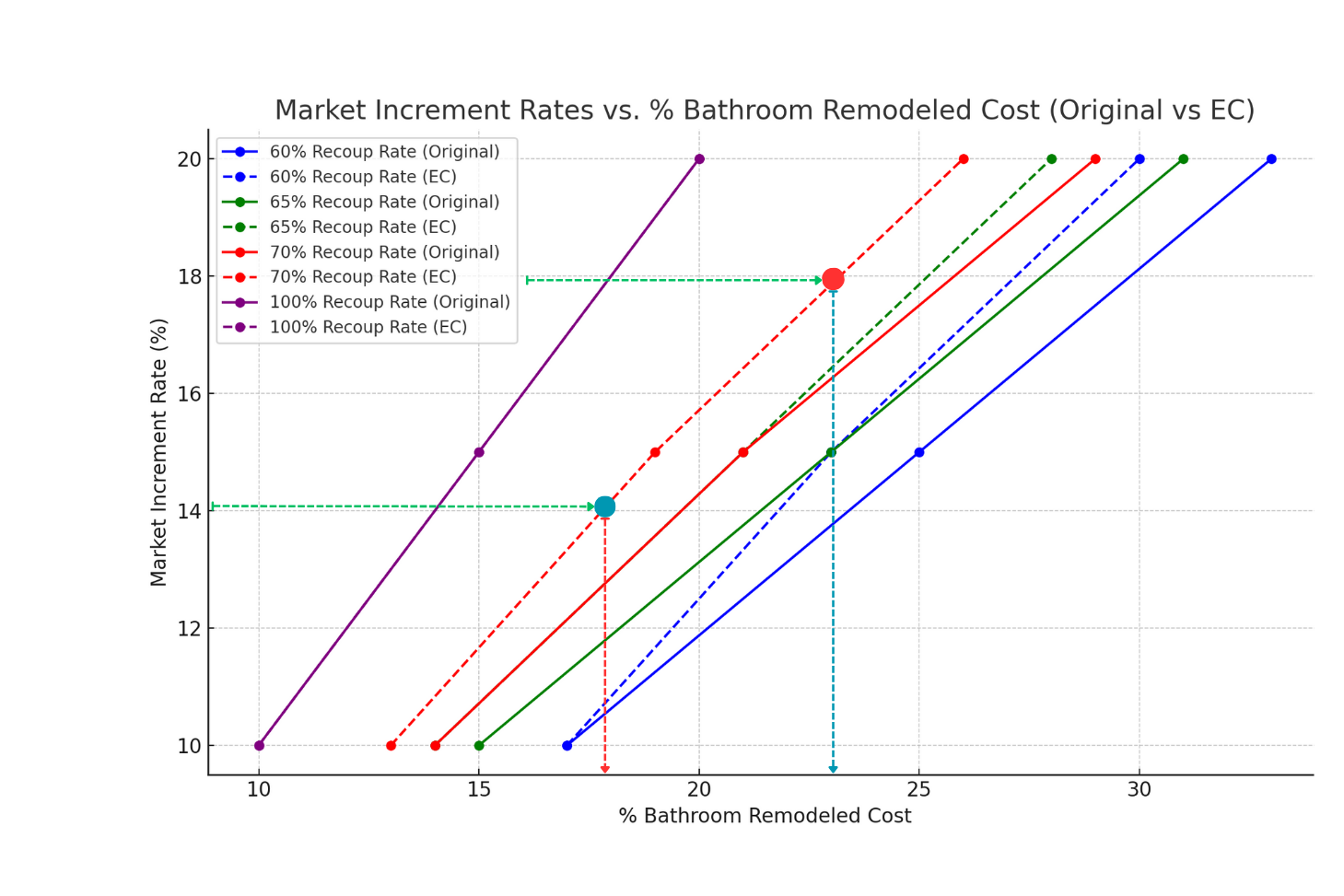
Economic and Profitability Considerations
Based on our model equation, ROI(t) = [RR + %Net Surplus] x %BRC(t) and using data from the Graphic above, the following table is compiled based on the particulars of Project A and Project B. Let’s assume the Market Value of Project Properties are the same and is $0.6M so as to focus on the effect of ROI, and %NetSurplus only.
| Metrics | Project A | Project B | A-B | A/B |
|---|---|---|---|---|
| Return on Investment | 18% | 14% | 4% | 1.29 |
| %NetSurplus | 8.3% | 7.8% | 0.5% | 1.06 |
| Recoup Rate | 70% | 70% | 0% | 1 |
| Equivalent Recoup Rate | 78.3% | 77.8% | 0.5% | 1.01 |
| Surplus Value Return | 10.6% | 10% | 12.62% | 1.06 |
| Surplus Value | $11,454 | $8,424 | $3,030 | 1.36 |
| Recouped Value | $96,600 | $75,600 | $21,000 | 1.28 |
| Property Increment Value | $108,000 | $84,000 | $24,000 | 1.29 |
| Bathroom Remodel Cost | $138,000 | $108,000 | $30,000 | 1.28 |
Project A seem to be the more attractive option due to its higher ROI, %NetSurplus, and Surplus Value indicating better efficiency in terms of investment to surplus conversion.
On that basis the final decision should weigh the importance of a higher %net surplus and surplus value (which favors Project A) against the lower investment required (which favors Project B).
A closer Look Considering % Surplus Value Return
An alternative approach would be to determine in which remodel property or remodel project was it possible to influence the Surplus Value expressed as a percentage of Property Increment Value achieved? i.e. the %Surplus Value Return = Surplus Value / Property Increment Value.
On that basis Property A continues to be superior to property B given that the Surplus Value Return is 10.6% versus 10% for Property B. But the margin of difference is minor.
Further, note that the difference between the surplus of A -B, expressed as a percentage of the difference in property increment value of A – B is 12.62% which is greater than the %Surplus Value Return of both A or B. This is a positive indication that the investment beyond the amount invested in B is yielding surpluses comparable or greater to B.
If investment cost reduction is a priority, Project B’s lower remodel cost with a respectable %Surplus Value Return, ROI and Surplus generation would be more appealing than that of Property A.
Observation 12 - Ultimately, the choice depends on the specific goals of the investment—whether maximizing immediate financial efficiency or focusing on the overall property value increase if cashflow is not a concern . Project B provides an almost equivalent %surplus return value for every dollar in property increment value gained, while Project A offers a higher total value increment in property value. Choosing between two projects in the same market can be challenging on the basis of ROI alone but when combined with the Surplus Value Return and other metrics a decision can be made relative easily.
Other Strategic Considerations
- Relative Rate of Recovery: The large variation in the ROI is not a good indicator for selecting between projects.
- Capital Availability and Cash Flow: The project with a higher ROI(t) requires more significant upfront investment probably owing to more luxurious renovations that strain budget constraints. Investors must therefore consider capital availability and how cash flow implications align with overall financial strategy when considering project A.
- Risk vs. Reward: Investors need to assess comfort levels of risk associated with each project’s ROI(t). A higher ROI(t) might tempt, but it usually comes with increased financial exposure and potentially greater market sensitivity.
- Long-term Goals and Portfolio Strategy: Beyond immediate financial returns, the investor should consider how each project fits within their broader investment portfolio and long-term goals. The project with a lower ROI(t) might offer more stability and consistency, aligning with a long-term wealth-building strategy, while the higher ROI(t) project could represent a strategic opportunity for quicker gains.
- Market Analysis and Buyer Demand: In-depth market research to understand buyer preferences and demand dynamics is crucial. The project with a higher ROI(t) might cater to emerging trends or niche demands, presenting a unique opportunity if market analysis supports the remodel’s focus.
Making the Decision
Ultimately, the decision hinges on a thorough evaluation of how each project’s specific attributes align. Starting with cost and scope to market positioning and timing, align with the investor’s objectives, financial capacity, and risk tolerance. Effective risk management, combined with a clear understanding of market trends and buyer preferences, will guide the investors toward the project that best matches their investment criteria and market expectations.
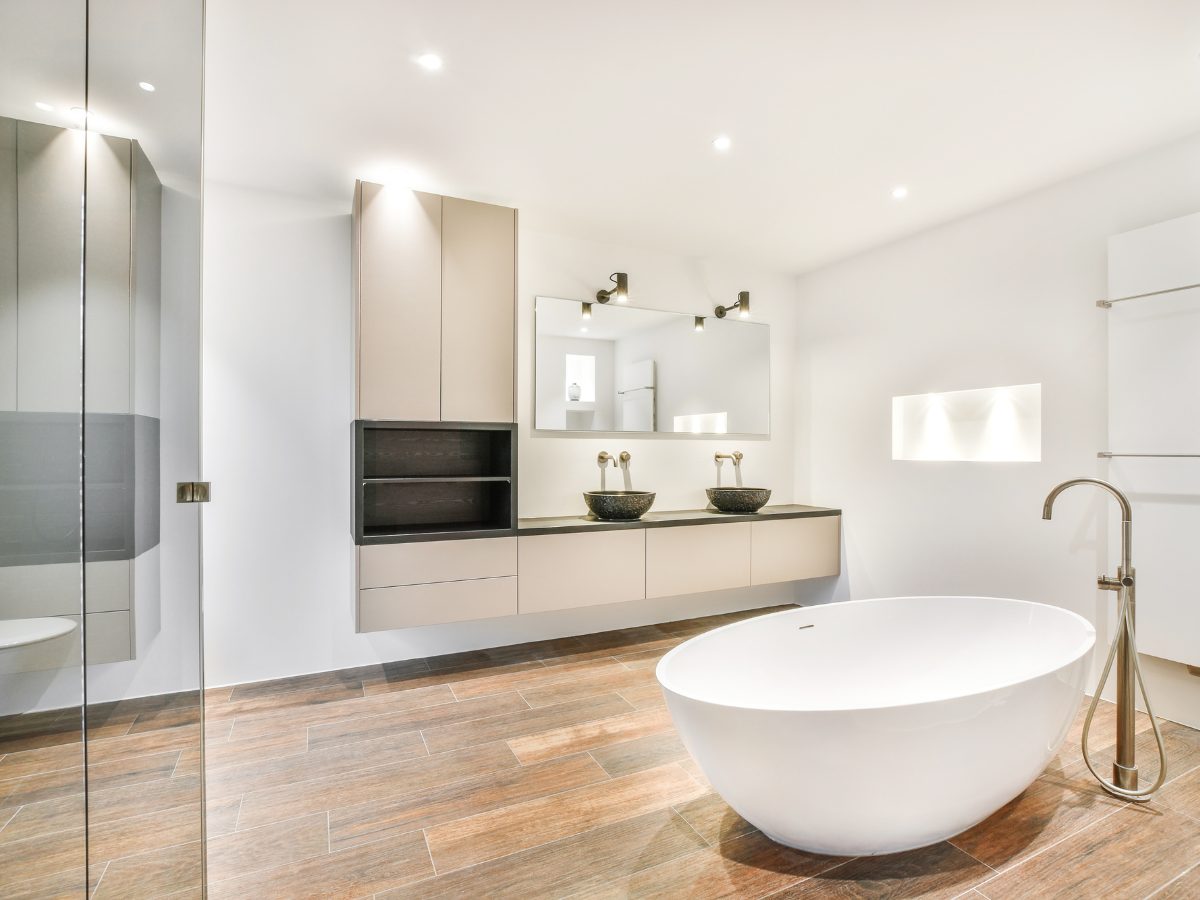
13. Decision Considerations
Considerations for Completed Projects – Changes in ROI and RR
The key issue here is that the Remodel is already completed. Irrespective of increases or decreases in ROI or RR the most pertinent strategy is to make adjustments to the selling price and marketing strategy. This could mean repositioning the property in the market for example - as a rental unit which would give time for the market to adjust. Altering the marketing approach, revising pricing expectations, or deciding to make some cost efficient modifications to the remodel in line with the market needs are also useful considerations. The investor may also decide to delay the sale until market demand improves.
Planned Projects considerations – Changes in ROI and RR
ROI Increasing - In an increasing ROI market, the investor's decision is twofold. Whether to stay at the current level of investment and reap benefits greater than planned or increase the level of investment to take full advantage of upswing. Choosing the correct pathway is key. Choose the pathway the maximizes the %Surplus Value Return. ROI Decreasing - Declining ROI does not necessarily imply a corresponding decrease in investment is required. The decision to invest more or not will depend on understanding future potential, and identifying the investment pathway that can position the remodel for success. RR Increasing - With increasing RR, this favors incorporating higher-end finishes, more extensive layout changes, or advanced features like smart home technologies. These features are now more likely to be valued by potential buyers. However, these must conform to the local market. RR Decreasing - In this case, the focus shifts from maximizing the efficiency of each invested dollar (when RR is increasing) on the remodel to maintaining or right sizing the level of investment (when RR is decreasing) to take advantage of future market opportunities. The key is to know your market.
Considerations For Comparing Projects
Choosing Between Projects in Different Market - This can be challenging when done on the basis of ROI alone but when combined with the %Surplus Value Return and other metrics a decision can be made relative easily. Everything else being equal always choose the project or investment pathway with the highest positive %Surplus Value Return, and Market Increment Value irrespective of market dynamics. We demonstrated this analysis in Case 5 above. Choosing Between Projects in Same Market - This can be challenging based on ROI alone, but when combined with Surplus Value Return and other metrics, a decision can be made relatively easily. Everything else being equal, always choose the project or investment pathway with the highest positive %Surplus Value Return and Market Increment Value irrespective of market dynamics. Please refer to Case 6 above.
Decision Rules for Investment Property
So far we have performed analysis to demonstrate how decisions affect financial outcomes regarding home value verses investment in a bathroom remodels.
We now present some key rules or practices that investors can used to improve investment spending decisions when planning a bathroom remodel project. Please read this section in conjunction with our Article on how to compile a remodel budget. – Bathroom Remodel Cost: Essential 2024 Guide To Budgeting Smart.
Decision Rule 1: Leverage Economies of Scale & Other Cost Reduction Measures: When planning a remodel or multiple remodels, look for opportunities to reduce costs through economies of scale, cost reductions, and engage in scope refinements so as to increase the %Surplus Value Return. These include bulk purchasing materials or negotiating better rates with contractors. Refer to Case 1 and Case 6 above.
%Surplus Value Return = Surplus Value / Property Increment Value
Decision Rule 2: Consider RR and ROI(t) Alignment: Choose remodel projects where the Recoup Rate and the target Return on Investment (ROI(t)) align with broader market conditions. Projects with a higher RR in a bullish market can justify a more significant investment or at least maintain planned investment levels. Please refer to Case 3 and Case 4 above
Decision Rule 3: Optimize for High RR: Aim for projects with the potential for a high RR, especially in markets where buyer demand is strong. High-quality finishes and functional layout changes can significantly impact the home's value. Please refer to Case 3 and Case 4 above
Decision Rule 4: Consider %NetSurplus and %BRC Alignment: To achieve a given ROI there may be multiple pathways. Remodel decisions are not always as simple as reducing or increasing investment levels (i.e. %BRC) but identifying the right pathway to maximize the %Net Surplus at a given RR. The interplay between %NetSurplus and %BRC is what leads to an optimum investment return. Please refer to Case 4, Case 5 and Case 6 above
Decision Rule 5: Monitor Market Trends: Stay updated on real estate and design trends. Before committing to a remodel, assess current market demand for the features you plan to update or add. Invest in upgrades that are most sought after in your specific market to ensure the remodel appeals to potential buyers. For each remodel feature, perform a cost-benefit analysis. Focus on updates that offer the highest potential enjoyment value to buyers for the lowest cost - this is not equivalent to choosing cheap fixtures. This means maximizing the efficiency of your investment and reducing cost but maintaining quality. Invest in modern, energy-efficient fixtures and popular design aesthetics to increase the property's appeal and value.
Decision Rule 6: Set a Budget Based on %BRC: Establish a budget based on the Bathroom Remodel Cost (BRC) relative to the property's market value. Prioritize spending on renovations that directly contribute to increasing the property's sale price. Focus on maximizing the %Surplus Value Return as noted in Decision Rule 1. Refer to Our Article How Much Should You Spend on a Bathroom Remodel? A Home Owner's Dilemma for an approach on how to set the an optimize range for investment levels, %BRC.
Decision Rule 7: Evaluate Long-term vs. Short-term Gains: Decide on the remodel scope based on your investment horizon. If you plan to sell shortly after the remodel, focus on updates that yield quick, visible improvements. For longer-term investments, consider upgrades that will offer lasting value. For detailed understanding on what features enhances ROI vs which maximizes Enjoyment Value please read our article - Bathroom Remodel Features: Return on Investment (ROI) vs Enjoyment Value
Decision Rule 8: Prepare for Market Changes: Be ready to adapt your remodel plan in response to shifting market conditions. Flexibility can help mitigate risks associated with unexpected changes in the real estate market. Review all the Cases above to review how market changes influences remodel decisions depending on whether the remodel is already completed or is being planned.
By following these decision rules, investors can approach bathroom remodel projects with a strategy that balances financial investment and strategic positioning.
14. Investment Property – Summary conclusions
The exploration of investment strategies in bathroom remodels for investment properties presents complexity and nuance for investment decisions. Key takeaways include the importance of aligning remodel projects with market demand. As well as assessing the the Recoup Rate RR, %return value return, and Target Return on Investment (ROI(t)) in decision-making, verses the need for flexibility in responding to market changes.
The cases presented above dissected the analysis between planned projects and completed projects. In both cases understanding where the market is or heading is important to optimize net Surplus. Through detailed case analyses, we’ve shown how the net Surplus of a bathroom remodel isn’t solely determined by the upfront investment cost but by the interplay between ROI, RR and the %Net Surplus Value and the investors strategy.
Strategic planning, informed by comprehensive market research and a clear understanding of buyer preferences, is essential. We also showed the significance of budget management, emphasizing cost efficiency and the need to avoid overcapitalization but also not to rush to reduce investment when RR decreases especially if the market downturn is expected to be short lived.
15. Practical focus on Investment Property
Investing in a bathroom remodel within investment properties demands a multidimensional approach, incorporating market analysis, financial planning, and strategic execution. The decision rules and case analyses presented provide a framework for investors to navigate the complexities of the investment effectively based on the specifics of your investment situation.
By prioritizing remodels that align with market demand, optimizing for high %Surplus Value Return, %Net Surplus value, RR and ROI(t), maintaining flexibility and having a focused strategy in the face of market volatility, investors can enhance the value of their properties and achieve their investment goals.
The ultimate success in bathroom remodel investments hinges on an investor’s ability to balance the appeal of modern, high-quality upgrades with cost-effective implementation. Recognizing the interplay between market conditions, buyer preferences, and investment strategies is crucial.

